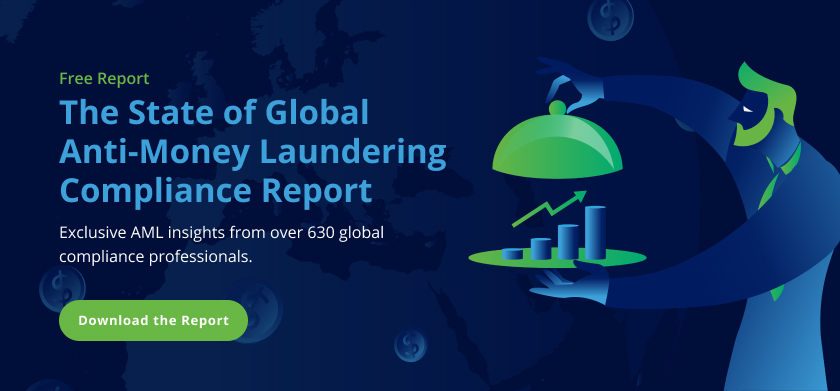
Feedzai’s new anti-money laundering report finds money mule schemes and cryptocurrency exchanges have become the favorite tactic of money launderers. However, most financial institutions aren’t utilizing available technology to address these threats.
Our new report, The State of Global Anti-Money Laundering Compliance, is based on responses from 636 answers submitted by anti-money laundering (AML) compliance experts around the world to 19 questions in four categories. The report sheds light on the challenges AML compliance professionals face in the fight against money laundering. This ranges from the growth of money mules to cryptocurrency risks to internal perception gaps and more. Money laundering supports a wide range of criminal activity including drug trafficking, financing of terrorism, and other serious crimes.
Here are some of the key findings from The State of Global Anti-Money Laundering Compliance Report.
Money Mules Are a Growing Threat in Anti-Money Laundering Report
Uncertain economic conditions are only adding to AML compliance professionals’ stress. A looming recession and rising inflation is contributing to economic anxiety and uncertainty for many people. It’s also creating fertile ground for criminals to recruit money mules into their scams.
Feedzai’s report found 74% of global banks cited money mules as their most common money laundering technique. The scope of the money mule threat is so severe that several global banks have issued warnings to their customers about the legal risks of participating in these schemes. Banks are even warning customers that they could face prison time for their participation, either witting, unwitting, or complicit.
Many AML professionals believe a RiskOps approach will allow AML and fraud teams to identify and respond to money mule activity faster by enabling smoother data sharing. Yet, roughly one-fifth of organizations said they don’t share data. Meanwhile, 15% said they don’t know if they do.
A Cryptocurrency Gap Emerges
The cryptocurrency landscape has also expanded in recent years. Unfortunately, criminals sometimes use crypto exchanges in their money laundering schemes. The report found 56% of respondents cited multi-customer, cross-wallet activity as the second most common money laundering typologies of concern.
Multi-customer, cross-wallet activity refers to a customer’s ability to have opaque fiat and crypto wallets with several financial institutions. This is a favorite tool of money launderers because it enables them to move funds between bank accounts while avoiding detection.
Despite ranking as a top concern for compliance teams, only 26% of respondents plan to evaluate cryptocurrency’s risk exposure. This highlights a serious gap in priorities for AML compliance teams.
Few FIs Use Data-Sharing to Combat Money Laundering
Cryptocurrency is not the only gap that Feedzai’s Anti-Money Laundering Report highlights. Most respondents said data sharing between financial institutions, in other words, a RiskOps approach is critical to detecting money mules and combat money laundering.
However, 19% of respondents said their AML and fraud teams do not share data despite this being an effective AML tactic.
Meanwhile, AML teams and management had different views on whether they already take a RiskOps approach to sharing data and creating a single customer view of risk. For example, 59% of fraud and AML analysts say they do not allow data sharing between fraud and AML teams. However, 53% of managers said they do. These figures indicate that AML compliance teams and leadership are not on the same page when it comes to addressing an organization’s data-sharing priorities.
Anti-Money Laundering Report Reveals Risk of ‘Silent Failures’
Amid these disconnects, the report reveals several important “silent failures” that have the potential to grow into bigger issues.
When asked to identify the top AML compliance issues and market challenges in the next two years, respondents named increased regulatory expectations, cryptocurrency, and blockchain as their top challenges. Meanwhile, staffing challenges were also listed as a priority. This indicates that AML compliance team staffing and employee training are not getting the attention that professionals feel they deserve.
Social media is another “silent failure” that deserves attention. Roughly one quarter of respondents said their organizations do not review social media as part of their due diligence and risk investigation process. This is a stunning revelation considering social media is where people voluntarily reveal information and affiliations.
Share this article:
Related Posts
0 Comments5 Minutes
Spotlight on Denmark: Fraud and Financial Crime Insights from ‘Den sorte svane’
The recent documentary mini-series "Den sorte svane" has sent shockwaves through Danish…
0 Comments9 Minutes
Enhancing AML Transparency with Smarter Data
Doesn’t it seem like new financial threats crop up in the blink of an eye? That’s why…
0 Comments10 Minutes
Enhancing Anti-money Laundering Systems Architecture
A speaker at a financial crime conference I recently attended summed up the problem with…

